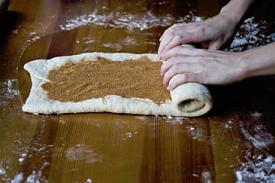Vegan Yum Yum (5 page)

step 5
Bake for 8 to10 minutes or until toast is toasty, and then finish under the broiler for 1 to 3 minutes until browned. Let cool a minute or two before slicing or eating.
Cinnamon Raisin Swirl Bread
I
used to buy cinnamon raisin swirl bread. One day I was eating a slice for breakfast and thought, “Why am I not making this myself?” Obviously it's easier to buy bread, but if you're up for it, it's super tasty and fun! I spent a lot of time on this recipe, so I hope it's successful for you, even if you've never attempted to make yeast bread before. (Mom, I'm looking at you.)
I weighed out the flour in this recipe to help you get more consistent results. Everyone's “1 cup of flour” varies in weight depending on your flour and your scooping technique. I reach into the bag with my 1-cup measure, get a heaping scoop, and then shake it until it's leveled off. That gets me 168 grams of bread flour per cup consistently. If you have a scale, measure one of your typical 1-cup scoops. It's good to know whether you generally scoop heavy or scoop light! Also, it's impossible to lose track of how many cups of flour you've measured if you're weighing it. Kitchen scales aren't that expensive, and they've saved me from ruining recipes more than once.
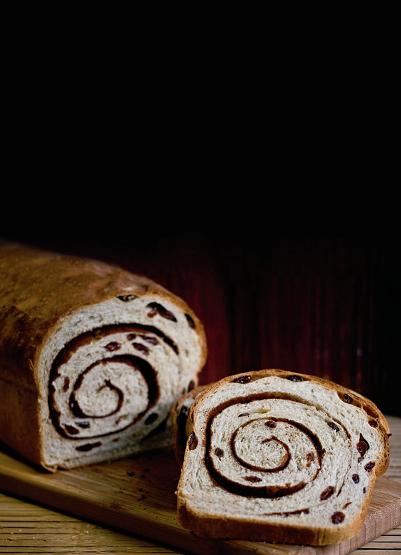
Cinnamon Raisin Swirl Bread
Makes 1 loaf
step 1
Grease a 9-by-5 inch loaf pan with vegetable oil or cooking spray and set aside.
step 2
In a small bowl, dissolve the yeast and sugar in the lukewarm water. The water should be between 105 and 110 ºF (it will feel on the cool side of hot if you're not using a thermometer, or as hot as your shower water or slightly hotter). Set aside to proof. If you're new to bread making, “proofing” is the process of activating yeast by mixing it with sugar and liquid.
step 3
Meanwhile, in a large bowl mix the flour, sugar, salt, and cinnamon together with a whisk until well combined. Create a well in the middle of the dry ingredients and pour in the bubbly, proofed yeast mixture and 1 cup of water. Mix with your hands until just combined. Add approximately half of the remaining water, depending on how dry the dough is.
step 4
Turn out onto a lightly floured surface and begin kneading. It's okay if the dough looks bumpy and messy at first. Add more water if needed, but you shouldn't need more than the full 1½ cups. Knead for 1 to 2 minutes until there are no more dry bits and the flour is fully incorporated into the dough; then let it rest for 5 minutes.
step 5
While the dough is resting, wash out the bowl you made it in, dry thoroughly, and lightly oil it with vegetable oil or cooking spray. If it has been less than 5 minutes, straighten up the kitchen or check your e-mail or something. You want the gluten you've activated to relax a little, or “autolyze,” if you want to use the technical term.
Ingredients
Bread
1 teaspoons dry active
teaspoons dry active
yeast
1 tablespoon sugar
¼ cup lukewarm water
(105 to 110 ºF)
4 cups bread flour
(672 grams)
2 tablespoons sugar
2 teaspoons salt
2 teaspoons cinnamon
1½ cups cool water
(divided into 1 cup and ½ cup)
 cup raisins
cup raisins
Spice Mixture:
4 tablespoons sugar
3 teaspoons cinnamon
1 small pinch allspice
(optional)
1 small pinch nutmeg
(optional)
step 6
After the dough has rested, knead it for 4 to 5 minutes or until smooth, elastic, and not sticky. Add more flour, sprinkle by sprinkle, if the dough is still sticky. Once it is smooth and elastic, form it into a ball and set it in the oiled bowl, turning it once so the surface of the ball is oiled as well. Cover lightly with oiled plastic wrap and put it in a warm place to rise for 2 to 2½ hours. If you don't have a warm place, turn your oven on for a minute and then turn it off. It should feel warmâbut not hotâinside. Let the dough rise in there. Don't forget it's in there and accidentally preheat your oven for something else!
step 7
Place the raisins in a small saucepan and cover, just barely, with water. Bring to a simmer, then turn off the heat. Let them sit for 10 minutes, which plumps the raisins and makes them juicier. Drain, pat dry, and toss with 1 tablespoon of flour to help them stick to the dough.
step 8
When the dough is done rising, it should be much larger and will dent when you poke it, as opposed to springing back.
step 9
Invert the bowl and scrape the dough out onto a lightly floured surface. Punch the dough down with your fist to deflate it. Stretch/press/roll it out to roughly 12 x 15 inches.
step 10
Sprinkle the dough evenly with the raisins and press them into the dough.
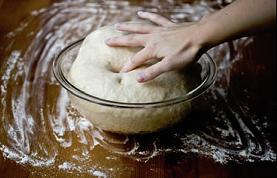
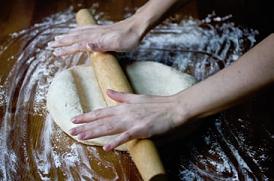
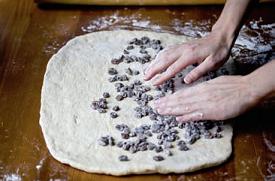
step 11
Fold the dough in thirds, lengthwise. Using a rolling pin, flatten out the dough into a rectangle that that is approximately ½-inch thick and 5 inches wide. It shouldn't be wider than the length of your loaf pan, or it won't fit!

step 12
Sprinkle the sugar and spice mixture (see above) over the dough evenly, leaving a ½-inch to 1-inch border of unsprinkled dough on three sides (two long ones and one short).
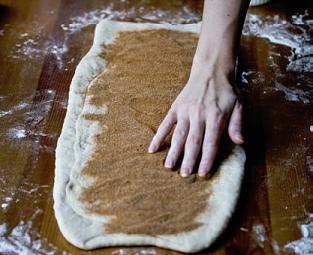
step 13
Starting from the short side that has no border, begin rolling the dough. The idea here is that the parts of the dough that don't have spices on them will stick together, making sure your loaf will stay together when you slice it after baking.
